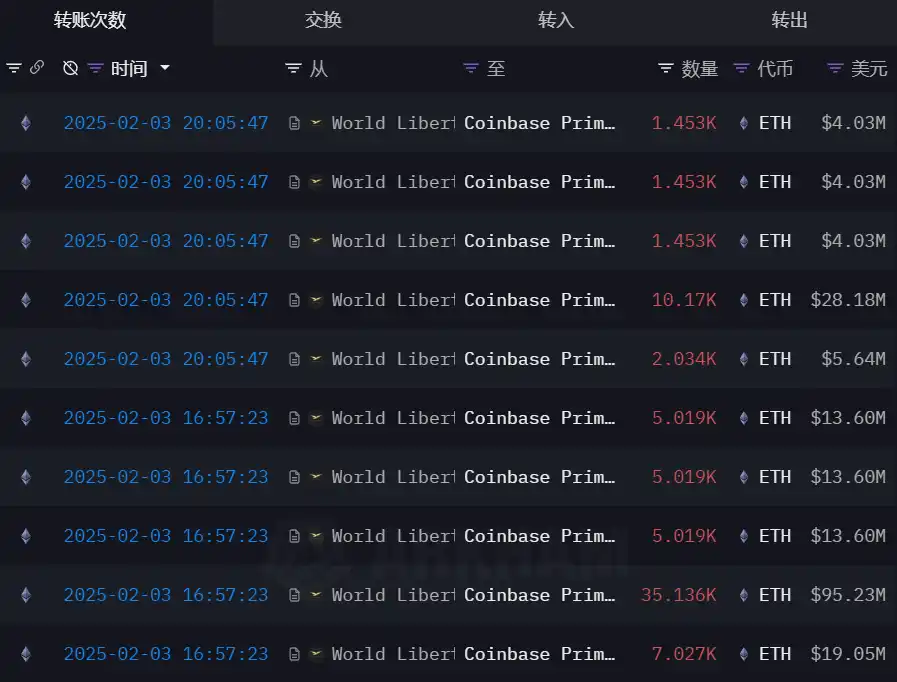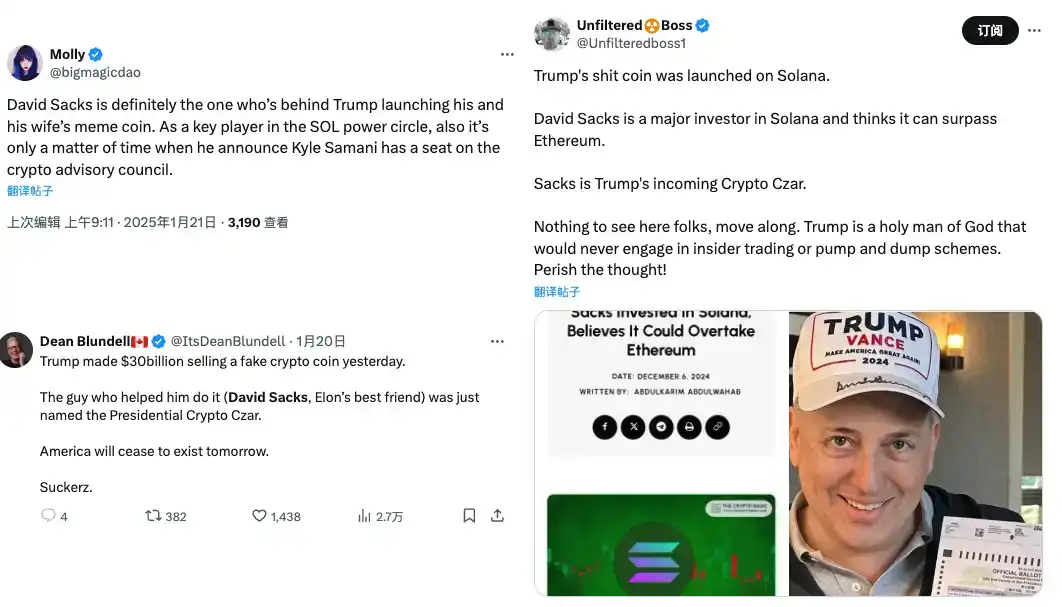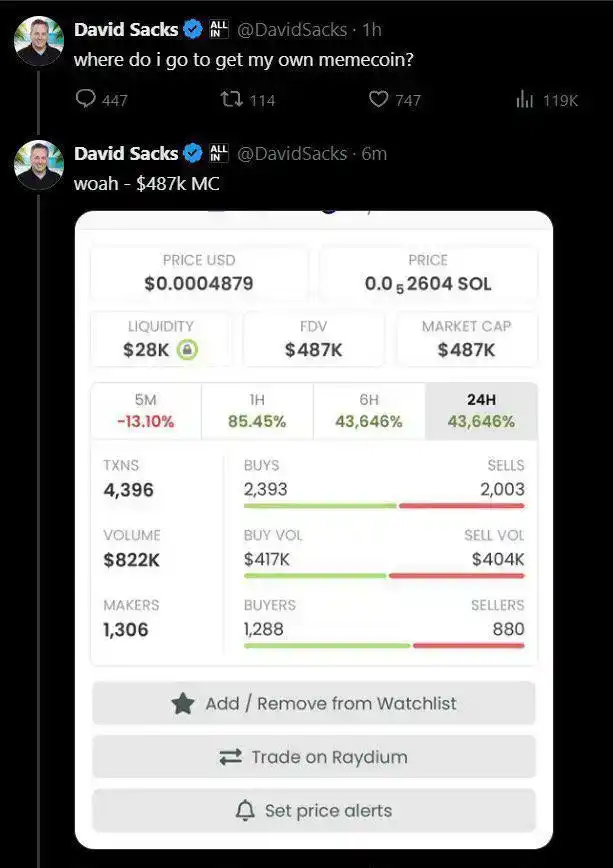Author: Penny, BlockBeats
Since former President Trump and his wife released their own Meme coin $TRUMP and $MELANIA, which attracted massive funding, the crypto market has quickly fallen into a state of liquidity shortage. On the other hand, the impact of the domestic AI large model DeepSeek, the cancellation of Bitcoin's legal tender status by sovereign states, and the additional tariffs imposed by the US have further exacerbated the already sluggish market.
The first major drop after the new year was triggered by Trump's tariff hike.
Are Crypto Prices Bound to Policies? The Highly Sensitive Crypto Market
Trump's tariff collection policy is severely impacting the market. On February 1, local time, US President Trump signed a tariff order, imposing an additional 25% tariff on imports from Canada and Mexico, and a 10% tariff on energy resources from Canada, effective on the 4th. Additionally, Trump signed an executive order on the 1st, imposing an additional 10% tariff on goods imported from mainland China.
The global risk market reacted quickly, with cryptocurrencies bearing the brunt. On the same day, the price of Bitcoin plummeted from around $105,000, breaching the $100,000 mark, and even briefly fell below $92,000, a drop of over 7% in 24 hours. Ethereum fell by about 25%, reaching its lowest level since early September last year, and other mainstream cryptocurrencies also experienced double-digit declines, a truly epic crash.

On February 3, Trump stated that he had reached an agreement with the President of Mexico to immediately suspend the expected tariffs for a month. After the tariff policy was delayed, Bitcoin rebounded to a high of $102,500, Ethereum rebounded to $2,923, and other mainstream coins also rebounded to pre-crash prices.
Bitwise Alpha's chief strategist, Jeff Park, said that tariffs may only be a temporary tool, but in the long run, Bitcoin will not only rise, but rise faster, as both sides of the trade imbalance want Bitcoin, so the ultimate result is the same: higher prices and faster speeds.
It can be said that the imposition of tariffs has led to a significant drop in global stock markets, and accompanied by other negative news, the crypto market has also experienced a decline. The imposition of tariffs is not only a reshaping of the international trade pattern, but also a heavy blow to the confidence of the global financial market. The crypto market, with its emerging, high-risk, high-return, and unregulated characteristics, has become one of the most sensitive areas in this storm, further proving the increasingly close connection between the crypto market and global macroeconomic policies.
Issuing Meme Coins to Bleed the Market
On January 18, 2025, Trump announced the launch of his personal Meme coin $TRUMP on his social media account. This coin skyrocketed over 15,000% to around $30 within just 12 hours, reaching a market cap of over $800 billion. This astonishing surge and massive market cap quickly attracted a large influx of funds, with many investors who originally invested in mainstream cryptocurrencies like BTC and ETH subsequently selling their other holdings to "All In" on $TRUMP, causing a short-term bloodbath in other coins, except for SOL, while other Meme coins and AI Agent tokens plummeted across the board.
Furthermore, the $TRUMP issuance team holds a staggering 80% of the locked-up coins, meaning they have an extremely strong ability to manipulate the coin price. After the lock-up period gradually unlocks, whether they directly dump the coins on exchanges or stake them on DeFi chains, it could have a huge impact on the market. This behavior will also further disrupt the market order in the crypto world, making it more difficult for other truly valuable crypto projects to obtain funding support, leading to an imbalance in the entire crypto ecosystem.
The bleeding effect brought by Trump's coin issuance has not only led to an unreasonable flow of funds in the crypto market in the short term, but has also had a serious negative impact on the development of other cryptocurrency projects and the stability of the market, putting the thriving DeSci, DeFAI, and AI Agent sectors on pause. According to the crypto world's usual practice of chasing new projects and abandoning old ones, these sectors will need even greater momentum to regain their former glory, leaving the crypto market facing more uncertainty and risk.
BitMEX co-founder and CIO Arthur Hayes believes that $TRUMP reaching a fully diluted valuation (FDV) of nearly $1 trillion in 24 hours is an absolutely absurd market signal, similar to FTX's purchase of MLB umpire advertising in the 2021 bull market - it symbolizes the approaching market top.
Clearing Positions and Shilling, WLFI's Confusing Behavior
Arkham data shows that World Liberty Financial (WLFI) conducted a large-scale cryptocurrency asset transfer on the evening of February 3, with its ETH holdings dropping from around 66k on February 2 to just 52, almost completely clearing its ETH assets, which mainly flowed into Coinbase Prime deposit addresses.

At this sensitive time of asset transfer, Eric Trump, the son of former President Trump, posted on his social media platform that it was the best time to add ETH (In my opinion, it's a great time to add ETH.). The original version of the tweet also included the line "You can thank me later."

The community expressed skepticism about this, with some attentive investors noting that the ETH holdings only decreased by one unit from 66k to 66, clearly trying to avoid detection of the asset transfer, and suspecting a conspiracy to "shear the sheep." WLFI explained that these measures were aimed at maintaining a strong, secure, and efficient financial system, and that the assets were simply reallocated for ordinary business purposes, and that they would not sell the tokens. However, once the funds are transferred to Coinbase Prime, we don't know what they will be used for, and investors can only analyze based on the coin price fluctuations and WLFI's subsequent asset operations.
Interestingly, on the morning of February 6, Eric publicly "shilled" BTC, while also mentioning the family project WLFI, with the community joking that "it's time to sell Bitcoin now." Perhaps this was a "shill" before an exit, perhaps to boost confidence that was dampened by the tariffs, or perhaps just routine promotion of the family project, as shilling and "cx" are the norm for these people.

The Crypto Tsar, but Also the Crypto Grim Reaper?
David Sacks, the chairman of the Crypto Council, is well-known as one of the founders of PayPal, and later became famous for creating Yammer and selling it to Microsoft for $1.2 billion. In the crypto world, David Sacks' most important identity is as an investor in the crypto venture capital firm Multicoin and a staunch supporter of Solana, earning him the title of "Crypto Tsar."
Since $TRUMP was deployed on the Solana chain, and David Sacks remained silent when Trump issued the $TRUMP coin, many believe that the chairman of the Crypto Council was definitely involved.

Another piece of evidence is that David Sacks has a "criminal record." In March 2024, David Sacks posted about his own Memecoin $Sacks.
Although he tweeted nine times telling people not to buy it when people started purchasing it, this has already proven that he "once issued a coin," which is exactly the same as the method of issuing $TRUMP. (According to feedback from community members, David Sacks has recently deleted his posts about $Sacks.)

This has caused many people to start disliking David Sacks, feeling that his methods are too eager for quick success and too aggressive in pursuing profits. Even if Sacks did not directly participate, as the chairman of the Crypto Council, he should also be held responsible for this incident. There are even rumors that someone has proposed that the entire leadership team of David Sacks' Crypto Council should be replaced with a new one.
On February 5, David Sacks reiterated his work goals of "clearly defining the crypto regulatory framework", "ensuring that crypto innovation occurs in the United States", and "creating a golden age for digital assets" at a press conference that started at 3:30 Beijing time, but did not announce any new (or specific) content. When mentioning the establishment of a Bitcoin reserve, David Sacks used the word "evaluate", which is a relatively mild affirmation (previously, the US government would use the word "evaluate" when it had to deal with the issue but did not want to really solve it). Affected by the fact that the press conference "did not release any positive news", Bitcoin fell back and broke below $99,000, with a low of $96,147.
Is it a true Builder, or an even bigger sickle?
Looking back at Trump's behavior over the years, his attitude towards cryptocurrencies has changed very clearly. During his previous term, he publicly stated that cryptocurrencies like Bitcoin are a "scam", but now he has promised to make the US the global "cryptocurrency capital" and "Bitcoin superpower", and has also formed a cryptocurrency group, established a family DeFi project, lifted restrictions on new token sales, and strengthened the connection between cryptocurrency companies and other traditional financial enterprises.
There may be multiple reasons behind Trump's change of attitude. On the one hand, the cryptocurrency market has developed rapidly in recent years, with a huge investor base and huge economic influence, and courting this force can help increase his political support; on the other hand, the cryptocurrency industry has a powerful interest group behind it, and these groups may have influenced Trump through political donations to promote policies favorable to the development of cryptocurrencies. In addition, Bitcoin can be seen as a tool to hedge against the weakening of the US dollar's status, and Trump's inclusion of it in the national strategic reserve is also a means to attract capital inflows and maintain the US dollar's hegemony.
As the election results are implemented, Trump's every move is gradually becoming a wind vane for the hot topics in the crypto circle. In particular, before taking office, Trump issued his own Meme coin, which caused countless investors both inside and outside the circle to go crazy, creating many phenomenal wealth myths, and it was thought that this was the beginning of the bull market, but the subsequent issuance of the $MELANIA token shattered this illusion, making the market calm down and doubt the purpose of his token issuance. The previously thriving AI Agent has been heavily bled by $TRUMP and $MELANIA, and has also been hit by deepseek, remaining sluggish. Although the frenzy of Meme is still continuing, the peak market value of a large number of tokens is constantly shrinking, and the time to zero is constantly shortening, and the mainstream coins continue to fall after the frenzy, we can't help but think, is Trump's pro-crypto purpose really to be a Builder, or to maximize profits for his interest groups and the US hegemony during his term, and leave a mess behind?
In the short term, the market will inevitably experience a surge and a plunge to digest various major moves, but the long-term value growth and industry precipitation requires not only policy incentives, but also a two-way game between the market and politicians. From his series of promises and statements, it seems that he has a positive and supportive attitude towards cryptocurrencies. However, the huge change in his past statements and positions makes it difficult to be fully convinced. Will he really spare no effort to promote the development of cryptocurrencies and make the US a paradise for cryptocurrencies? After taking office, whether the promised positive policies can be implemented or whether it is just a surface act for political interests, these questions are full of uncertainty.
For crypto investors, Trump's current attitude and policy direction is like a double-edged sword. If he can really fulfill his promises and create a relaxed and friendly development environment for cryptocurrencies, then the crypto circle may usher in a new round of prosperity; but Trump's frequent sanctions on other countries after taking office, the businessman style that has been criticized by himself and his family members, and the internal contradictions and divisions within his team, will all exacerbate the instability of the global economy and politics, making his crypto policies unpredictable, and this instability will cause panic sentiment to spread among investors, which will have a negative impact on the cryptocurrency market.
It can be said that Trump's imposition of tariffs is just the beginning of his impact on the crypto circle after taking office. In the future, as he pushes forward and implements policies in areas such as economy and diplomacy, the crypto circle will most likely face even more violent fluctuations. Investors in such an environment need to closely monitor policy dynamics and make investment decisions more cautiously.
The bigger the waves, the bigger the fish. Regardless of the unknown ahead, this crypto ship has set sail and is ready to face the stormy waves.






